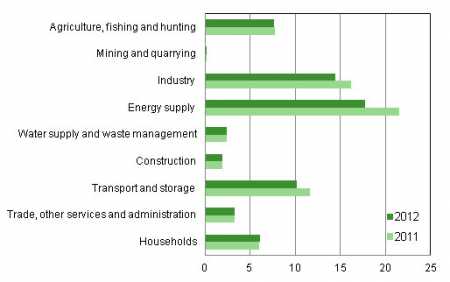|
Fri, 26 Sep, 2014 12:04:05 AM FTimes Report, Sept 26  Greenhouse gas emissions by industry 2011 and 2012, million tonnes CO2 equivalent. Source: Statistics Finland. The fallen industrial production and the lower use of fossil fuels and peat decreased greenhouse gas emissions in the country in 2012.
Besides imported electricity, the use of oil, coal, natural gas and peat was replaced by wood fuels, whose carbon dioxide emissions are not counted in greenhouse gas emissions.
In contrast, households' greenhouse gas emissions grew slightly. This data is derived from Statistics Finland's statistics on emissions into air by industry, where emissions are calculated according to the industrial classification used in national accounts.
Carbon dioxide emissions originating from biofuels grew in almost all industry groups as the use of wood fuels and liquid biofuels increased. Greenhouse gas emissions in transportation and storage went down by nearly 13 per cent mainly as transports decreased, but the increase in liquid biofuels also contributed to this.
In addition to greenhouse gas emissions, the division of air emissions by industry is included in the statistics on many different emission types. In 2012, 39 per cent of nitrogen dioxide was produced by the transportation and storage industry, 17 per cent by energy supply and 16 per cent by manufacturing.
Over 50 per cent of carbon monoxide emissions originated from households. Energy supply and manufacturing both produced good 30 per cent of sulphur dioxide emissions, and transportation and storage slightly under 30 per cent.
The statistics on emissions into air by industry are part of environmental accounts, where the main principle is to describe the interaction between the environment and the economy. In the statistics, emissions are presented according to the industrial classification used in national accounts.
In this way, the data on emissions into air can be directly connected to various monetary variables of national accounts, such as total output and value added.
More News
|
|
Finland Times
| Saturday, 27 April, 2024 |

